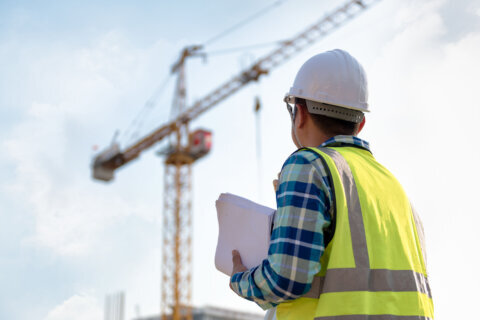With the opening of the first phase of its second headquarters, HQ2 at Metropolitan Park, Amazon has made sustainability a reality.
At HQ2, Amazon has created a workspace powered by 100% renewable energy that will produce zero carbon emissions. It’s a combination Amazon and its design and construction team hopes others will follow.
“This building is operating with zero carbon emissions through the use of an all-electric central plant and high-performance systems that drive down energy demand,” said Fernando Arias, director of sustainability at Clark Construction Group, which led the construction of Amazon’s Metropolitan park towers.
Arias, along with other members of the construction and design team, shared details about HQ2 during a panel discussion held in the building’s community event space just after the opening of the new Amazon campus this June. The two, 22-floor towers, featuring 2.1 million square feet of office space and 50,000 square feet of ground floor retail space, are now open at Met Park. Amazon employees have begun moving in, and several of the 14 local retail businesses at HQ2 are now open as well.
“The buildings, the HVAC systems that heat and cool the space, the water heaters that serve the sinks and showers, and even the food service equipment used in our kitchens are powered fully from electricity,” Arias shared. “100% of the retail spaces will also be all-electric.”
Committed to lasting sustainability at Amazon HQ2 and beyond
The panel discussion was also a chance to celebrate achieving goals that Amazon and its design and construction partners believe will set the standard for the creation of other new sustainable, multiuse workspaces in the Washington metropolitan region and beyond.
HQ2 embodies Amazon’s commitment to The Climate Pledge, said Gina Klem, the company’s director of workplace innovation and sustainability. More than 400 companies worldwide have joined in committing to The Climate Pledge, launched by Amazon and Global Optimism in 2019. Their commitment? To achieve net-zero carbon emissions by 2040.
“At Amazon, we are laser focused on reaching our Climate Pledge commitment … and our buildings are a big piece of this puzzle,” she said. “Amazon is committed to decarbonizing all of its buildings — whether that’s our corporate offices, retail, data centers or fulfilment network — given the climate impact of the built environment.”
Buildings account for nearly 40% of carbon dioxide emissions in the United States, and they consume more energy than both the industrial and transportation sectors. Those statistics underline why Amazon wants to be at net-zero carbon emissions 10 years ahead of the Paris Climate Agreement, which set a worldwide goal of 2050, Klem said.
“We worked closely with the Amazon team to design and create a functional, beautiful space that would also be powered without any fossil fuels,” said Brian Earle, lead architect and principal at ZGF, which led design of HQ2. “This was no small feat and was a years-long process. Amazon really helped push the limit and is propelling the industry forward in that sense.”
Embracing innovation in HQ2’s building design
Amazon is on a path to power 100% of its operations with renewable energy by 2025. It is a push that has raised the bar in the company’s approach to construction and requires a team with a can-do attitude, Klem said. Close collaboration with partners and suppliers was essential in turning challenges into opportunities, she said.
Eliminating the use of fossil fuels is only part of the HQ2 sustainability story. Designing and constructing a building with sustainability at its core puts a premium on innovation, said Charlie Gronek, development manager for real estate developer the Seneca Group.
Met Park is also designed to recycle over 7.5 million gallons of water annually by capturing and reusing rainwater, shower water and condensation from the building’s heating and air conditioning systems. HQ2 is designed to use 50% less water than the local building code requires,” Gronek said.
“I love the small hidden things in buildings, and one in particular that I really like at Met Park is the heat exchanger that uses ground water to cool the building, saving water and energy,” he said. “It’s a great example of the team seeking out innovative ways to leverage resources on site. It is part of our strategy to reduce cooling tower water use by more than 2 million gallons of water per year — by preheating domestic hot water through water-to-water heat pumps and by exchanging heat with the local groundwater.”
Amazon is also encouraging its employees, or “Amazonians” in the company vernacular, to use the Metro, bike or walk when coming and going from their offices on the campus. As a commuter benefit, Amazon offers subsidized transportation each month to all corporate employees for transit cards, bikes and rideshare funds. Met Park also has a half-mile of new, protected bike lanes, a state-of-the-art bike room with more than 600 bike racks, 290 EV vehicle charging stations and multiple pedestrian pathways for walking to work and commuting via Metro, Klem said.
Creating public spaces inside and out at Amazon HQ2
The design and building team also worked hard to bring a “living feeling” to the indoor and outdoor areas at HQ2, Klem said.
“One of my personal favorite elements is that Met Park has over two acres of landscaped roofs and terraces,” she said. “These spaces include native adaptive plantings that are conducive to the climate of Arlington and serve as a calming environment to be used as gathering and meeting places for employees.”
Perhaps most striking, HQ2 is nestled in its new Arlington neighborhood like it has been there for years.
As part of Amazon’s commitment to be part of the community where it is making its new home, Met Park includes new and restored public open spaces and has been designed for a variety of uses. In addition to its offices, a community tech training lab, public-use meeting spaces, the campus is home to a dog park, recreation areas, children’s play area and farmers markets — all part of helping realize the community’s vision for a large, centrally located park environment, Klem said.







